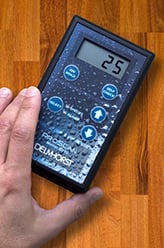 Handling water damage restoration work can be challenging even for the most meticulous contractors. Restoration clients demand thorough work, and missing even a minor pocket of moisture can result in further damage to a structure weeks after your job was “finished.”
Handling water damage restoration work can be challenging even for the most meticulous contractors. Restoration clients demand thorough work, and missing even a minor pocket of moisture can result in further damage to a structure weeks after your job was “finished.”
The threat of hidden pockets of moisture is one of the key reasons why top-performing restoration companies use a moisture detector for restoration work.
However, not just any moisture detector will do for restoration work. To ensure the quick identification and remediation of moisture pockets takes accurate, versatile tools, sometimes used in combination.
Tips for Picking a Moisture Detector
There are a lot of different devices on the market that can detect the presence of moisture in building materials. One of the most common is the pin-type moisture meter; another is the pinless moisture meter.
When looking for a moisture detector for restoration work, it’s important to have the right one for the job.
How can you tell if a moisture detector is right for you? Here are a few basic tips for picking a device:
- Check for Alternate Material Scales. On a restoration job, you never know what kind of building materials you’ll have to deal with. If your detector isn’t calibrated for the type of material you’re checking, then you’ll have to manually adjust your reading results, which takes time and increases the risk of misreading the moisture content of materials. Alternate scales such as drywall, wood, and reference scales allow you to take reading results in multiple kinds of building materials with a single meter.
- Balance Your Need for Speed Vs Specificity. Pin and pinless moisture detectors have different strengths and weaknesses when checking for moisture on a restoration job. Pinless devices are better at checking large areas of a structure for moisture quickly, while pin-type moisture detectors are better at determining the exact location of a moisture pocket. Balance your need to save time finding moisture with your need for precise information about moisture location when choosing between pin and pinless meters.
- Check the Manufacturer’s After Sales Support. A manufacturer’s after sales support can make a huge difference in the ownership experience you get with your meter. Everything from the warranty to the availability of customer support resources (via phone or web) can help you make the most out of your moisture detectors.
Picking the right moisture detecting equipment is the first step in ensuring a smooth restoration job.
Using Moisture Detectors for Restoration Work
The basic operation of most moisture detectors is quite simple whether you’re using a pin-type device or a pinless one. However, there’s more to getting the most out of your moisture detecting equipment than pushing a button.
Here are a few quick tips for using moisture detectors for restoration jobs:
- Use Multiple Meter Types. Rather than just sticking with a pin or a pinless meter, consider using both on the job. Pinless meters can help you quickly identify the presence of a moisture pocket, while pin meters can let you determine the exact location of moisture within building materials. Also, there are some situations where one kind of device might be able to get readings where the other cannot.
- Regularly Check Meter Calibration. At the start of each job, or even at the start of each day, test the calibration of your moisture detectors before you start taking readings to ensure accuracy. This can be done in several ways depending on the moisture detectors you use. For example, some devices come with a built-in calibration check, while others use a separate moisture content standard tool.
- Check Relative Humidity for the Rooms You’re Working in. The ambient humidity in the air can have a huge impact on remediation efforts, as well as indicate the presence of a continuous source of moisture. So, when working to remediate moisture damage, it’s important to set up a thermo-hygrometer to monitor the relative humidity in the air.
Following these tips can help ensure that your moisture readings are accurate and that your restoration work can be done quickly and efficiently. Learn more about using moisture detection equipment for restoration by checking out some of our other resources.

Comments